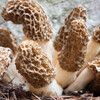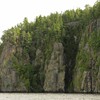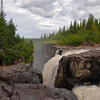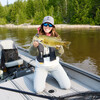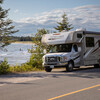
In Pursuit of the Ever-Elusive Moose

With the leaves starting to change and evenings growing cooler, Ontario moose-hunting enthusiasts are gearing up for the annual pilgrimage into Bullwinkle’s domain. Even with some of the most ambitious management initiatives currently underway to give our goofy-looking “swamp donkey” a helping hand, hunters and lodge owners alike await the season opener with bated breath.

The majestic Alces alces americana, or Eastern Moose, has long been the symbol of Ontario’s northern woods. Our largest member of the deer or ungulate family plays a vital role in many aspects of the province’s economy and tourism, from outfitter lodges to wildlife management. The Canada Moose, with their large size and highly coveted flesh, have always played an important ecological role in this scenic part of the province.
Facing Threats
These cloven-hoofed monarchs have faced tough times in recent years. Harsher than normal winters, habitat competition with deer, and parasites have caused a decline in moose numbers, especially in parts of the North and Northeast. The winter tick, for example, is a deadly threat to moose. Warmer, milder winters with snowpack melting earlier than usual have made for ideal tick production and range expansion.
Winter ticks affect moose by gorging on their blood and draining energy reserves at a crucial time of year. The calves and aging population are most vulnerable. Brainworm is another limiting factor in more southern areas of the region, where deer and moose populations overlap. All these factors and more have conspired to lower the province’s moose population. Once estimated at nearly 120,000 animals, their numbers are down to just over 90,000 today.
Managing Populations
The number of moose tags available to hunters has gone from 47,000 back in 1984, down to just over 13,000 in 2015. The Ministry of Natural Resources & Forestry (MNRF) stepped in last year to limit tag allocation and shorten the hunting seasons, with hopes of allowing moose numbers a chance to recover. Since it takes three years for a calf to become a breeding female, we likely won’t see any noticeable impact for a couple of years. Moose hunters and lodges in this region must learn to cope and adjust to a population on the rebuild.
All this to say, the moose hunt will continue on. Nevertheless, undaunted lodge owners like Ray & Donna Sapiano at Marten River Lodge must rejig their fall moose hunts. “Marten River Lodge sits on the border of zones 40 and 41... and we welcome bow hunters during the bows-only period,” they explain.

A Time-Honoured Tradition
Hunting the elusive Canada moose is a sport of passion and skill and a time-honoured tradition shared by many. No other type of pursuit is as variable or dependent on factors such as weather, location, and habitat as moose hunting is. Success rates can often vary from less than 5% per hunter to over 90%, depending on the region, weather conditions and hunter’s capability. Marten River Lodge is surrounded by Crown land with a network of old logging roads and acres of marshes, which is the perfect habitat for Ontario’s largest ungulate.
Keep in mind that not every hunter will have the opportunity to see, let alone harvest, one of these magnificent beasts. The challenge and excitement of an Ontario moose hunt keep hunters coming back year after year. The long hours in the bush and money spent is rewarded in a variety of different ways. Moose hunting is not all about putting a trophy on the wall. It is a tool of wildlife management and an extremely challenging sport – and if you have ever tried moose meat, the table fare isn’t too shabby either.
If you are lucky enough to have taken a moose this fall, be sure to try this recipe from my Canadian Outdoor Cookbook, published by Company’s Coming.
Barbecued Moose Recipe
Serves four
Many people consider moose meat, regardless of how it is cooked, the king of wild red meats! Once you get past the idea of eating wild game, you will find that moose is every bit as good as beef and a whole lot healthier. For those of you who have never tried moose, you will be surprised to learn how mildly flavourful and similar to beef it is. In my experience, moose tends to be more tender and less stringy than some cuts of beef and is typically a lot milder than other wild game meats. Trust me: you will want to invite “the king” to every barbecue!
Ingredients:
4 × 14 to 16-oz moose steaks (sirloin or T-bone)
Marinade:
- 2 tbsp vinegar
- ½ cup olive oil
- 1 garlic clove, crushed
- 1 tsp salt
- ½ tsp pepper
Mix marinade ingredients in small pan and bring to a boil. Cool. Place steaks in shallow baking dish and pour marinade over top; marinate in cooler or refrigerator for at least three hours. Prepare campfire or preheat grill to medium. Remove steaks from marinade, and discard marinade. Sear steaks on cooking grid over coals or on grill until slightly pink inside. Serve with potatoes, rice or salad.
-------------------------------
For anyone planning a moose adventure in the Marten River area, contact Ray & Donna Sapiano at Marten River Lodge.
Check here for more information on moose hunting in Ontario.
Recommended Articles
The Seven's Best Hikes, Biking Trails and Lakes

7 Best Spots to Check Out in The Seven

Budget Bliss: Explore Northeastern Ontario Without Breaking the Bank

Bring Your Fam!

Time to Unwind: 6 Spa Havens to Discover In The Seven
5 Amazing Places to SUP in Northeastern Ontario

5 Amazing Bike Rides to Discover

Northern Lights in Northeastern Ontario

Northeastern Ontario's Best Pride Festivals

Fish for one of the World's Rarest Species of Trout

An Insider's Guide to Manitoulin Island

6 Small-Town Gems to Explore in Northeastern Ontario

11 Best Things to Do in Kapuskasing, Ontario








